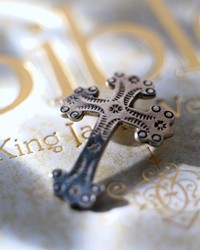
The speaker actually never places his finger on the scroll itself but will use a metal or wooden instrument about eight inches long, called a yad, which resembles a small hand with a single index finger pointing upward. Called the finger of God, this object is used by the reader and speaker to follow the lines of the text. This serves a dual purpose: it preserves the sanctity of the scroll, and it prevents oily, human fingers from eventually erasing the black-inked letters on the parchment.
It should be pointed out that the Torah is dressed to imitate the high priest’s garments. In Exodus 28, the outfit of the priests included a tunic, a belt, a crown, and a breastplate. These four items are a part of the Torah’s decoration in the synagogue.
The tunic is the beautiful embroidered covering for the scroll, similar to the blue garment of the high priest. Just as the high priest had a crown placed on his head, each Torah scroll has a beautiful crown of silver that sits atop the handle of the roller. The priest’s garment had a special belt fitting around the waist. Likewise, a sash ties the scroll together before placing the adorning cover over it.
The high priest also was given a unique breastplate of gold with twelve embedded gemstones engraved with the names of the twelve tribes. A silver plate, similar to the priest’s breastplate, is hung over the top of the wooden rollers.
The Torah is so holy that it is considered on the same level as a human being. Heroic stories are told of Jewish men who risked their lives through the smoke and the flames to rescue a Torah scroll from its ark when synagogues were burned in Europe in years past. This should come as no surprise, since the apostle Paul wrote: “For the word of God is quick, and powerful, and sharper than any twoedged sword” (Heb. 4:12, KJV). The Greek word quick means “alive”!
I have in my personal possession a 300-year-old nonkosher (meaning the ink has faded) Torah scroll given as a gift from a Jewish family from a Russian synagogue. It is encased in a wooden case. I still can sense a special awe when I see it.
After a scroll is used for many years, the ink on the parchment can begin to fade. Once the Hebrew text becomes unreadable, the scroll is not destroyed but is removed from its place and is buried in a Jewish cemetery just like a person. This is because the Torah gives life to the believer and must be respected in burial in the same manner of a righteous person.














































